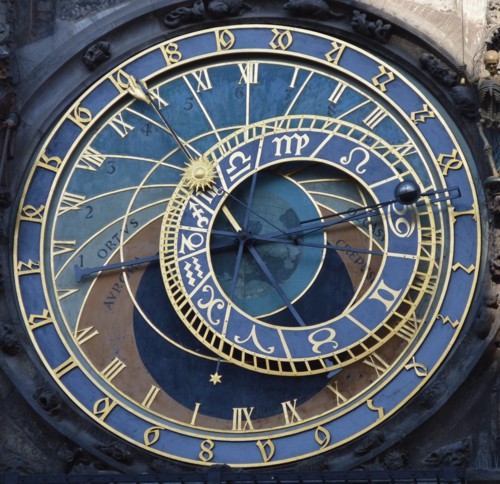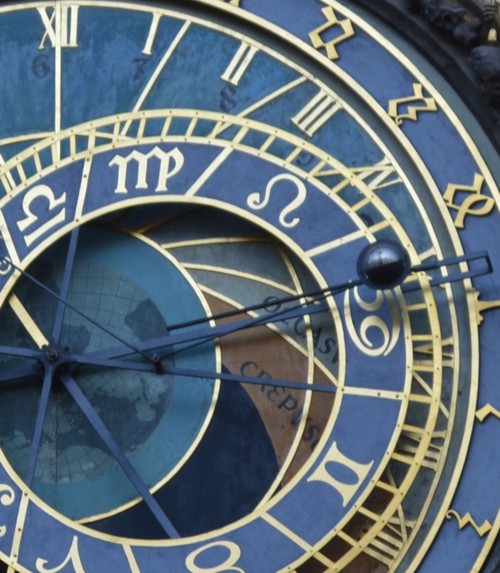Photo was taken at 9:52 am on Nov. 2, 2015
Old Czech time
The position of the golden hand over golden Schwabacher numerals indicates about 17:05 (24 indicating the time of sunset). Sunset occurs on November 1 at 16:40
Prague loccal time
The position of the golden hand over the Roman numerals on the background indicates 9:52 a.m.
Unequal hours
Sunrise
marked the beginning of the first hour (the zero hour), the middle of the day
was at the end of the sixth hour and sunset at the end of the twelfth hour. This
meant that the duration of hours varied with the season. In the Northern
hemisphere, particularly in the more northerly latitudes, summer daytime hours
were longer than winter daytime hours, each being one twelfth of the time
between sunrise and sunset. These variable-length hours were variously known as
temporal, unequal, or seasonal hours and were in use until the appearance of the
mechanical clock, which furthered the adoption of equal length hours.
This is also the system used in Jewish law and frequently called "Talmudic hour"
(Sha'a Zemanit) in a variety of texts. The talmudic hour is one twelfth of time
elapsed from sunrise to sunset, day hours therefore being longer than night
hours in the summer; in winter they reverse.
The POSITION OF THE SUN over the curved golden lines indicates about 3:00.
Sunrise occurs on November 2 at 6:53
Zodiac signs
The sun is in the sign of Scorpio (October 24-November 22)
Moon
Data for November 2, 9:52:
Phase: 61%, 20.37 days old.
Moon set: 12:36
Local Sidereal Time
Sidereal time, at any moment (and at a given
locality defined by its geographical longitude), more precisely Local Apparent
Sidereal Time (LAST), is defined as the hour angle of the vernal equinox at that
locality: it has the same value as the right ascension of any celestial body
that is crossing the local meridian at that same moment.
At the moment when the vernal equinox crosses the local meridian, Local Apparent
Sidereal Time is 00:00. Greenwich Apparent Sidereal Time (GAST) is the hour
angle of the vernal equinox at the prime meridian at Greenwich, England.
Local Sidereal Time at any locality differs from the Greenwich Sidereal Time
value of the same moment, by an amount that is proportional to the longitude of
the locality. When one moves eastward 15° in longitude, sidereal time is larger
by one sidereal hour (note that it wraps around at 24 hours). Unlike the
reckoning of local solar time in "time zones," incrementing by (usually) one
hour, differences in local sidereal time are reckoned based on actual measured
longitude, to the accuracy of the measurement of the longitude, not just in
whole hours.

